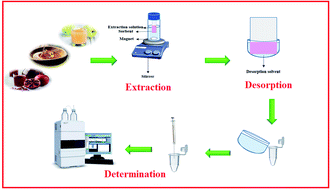Determination of quercetin via thin film microextraction using the in situ growth of Co–Al-layered double hydroxide nanosheets on an electrochemically anodized aluminum substrate followed by HPLC†
Abstract
The present study explains the in situ growth of Co–Al layered double hydroxide coated on an anodized aluminum substrate for thin film microextraction (TFME) approach. Anodizing process was performed by applying an electrochemical (chronoamperometry) method on a cost-effective Al foil used as a substrate. A multivariate optimization method has been explored for the TFME of quercetin from different kinds of honey and fruit juice samples by using the prepared anion exchangeable film. After TFME, the analyte was quantified via high performance liquid chromatography-UV detection (HPLC-UV). The Plackett–Burman design was employed for screening experimental factors. The effective factors were then optimized using Box–Behnken Design (BBD). Under the optimized conditions, the obtained limit of detection and limit of quantification were 0.18 and 0.61 μg L−1, respectively. The batch-to-batch reproducibility at 50 μg L−1 concentration level was 4.3% (n = 3). The validation results allowed the method to be utilized in the quantification of quercetin in real samples.



 Please wait while we load your content...
Please wait while we load your content...